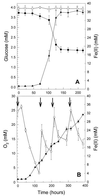Microbial reduction of Fe(III) in acidic sediments: isolation of Acidiphilium cryptum JF-5 capable of coupling the reduction of Fe(III) to the oxidation of glucose
- PMID: 10427060
- PMCID: PMC91545
- DOI: 10.1128/AEM.65.8.3633-3640.1999
Microbial reduction of Fe(III) in acidic sediments: isolation of Acidiphilium cryptum JF-5 capable of coupling the reduction of Fe(III) to the oxidation of glucose
Abstract
To evaluate the microbial populations involved in the reduction of Fe(III) in an acidic, iron-rich sediment, the anaerobic flow of supplemental carbon and reductant was evaluated in sediment microcosms at the in situ temperature of 12 degrees C. Supplemental glucose and cellobiose stimulated the formation of Fe(II); 42 and 21% of the reducing equivalents that were theoretically obtained from glucose and cellobiose, respectively, were recovered in Fe(II). Likewise, supplemental H(2) was consumed by acidic sediments and yielded additional amounts of Fe(II) in a ratio of approximately 1:2. In contrast, supplemental lactate did not stimulate the formation of Fe(II). Supplemental acetate was not consumed and inhibited the formation of Fe(II). Most-probable-number estimates demonstrated that glucose-utilizing acidophilic Fe(III)-reducing bacteria approximated to 1% of the total direct counts of 4', 6-diamidino-2-phenylindole-stained bacteria. From the highest growth-positive dilution of the most-probable-number series at pH 2. 3 supplemented with glucose, an isolate, JF-5, that could dissimilate Fe(III) was obtained. JF-5 was an acidophilic, gram-negative, facultative anaerobe that completely oxidized the following substrates via the dissimilation of Fe(III): glucose, fructose, xylose, ethanol, glycerol, malate, glutamate, fumarate, citrate, succinate, and H(2). Growth and the reduction of Fe(III) did not occur in the presence of acetate. Cells of JF-5 grown under Fe(III)-reducing conditions formed blebs, i.e., protrusions that were still in contact with the cytoplasmic membrane. Analysis of the 16S rRNA gene sequence of JF-5 demonstrated that it was closely related to an Australian isolate of Acidiphilium cryptum (99.6% sequence similarity), an organism not previously shown to couple the complete oxidation of sugars to the reduction of Fe(III). These collective results indicate that the in situ reduction of Fe(III) in acidic sediments can be mediated by heterotrophic Acidiphilium species that are capable of coupling the reduction of Fe(III) to the complete oxidation of a large variety of substrates including glucose and H(2).
Figures



References
-
- Alef K. Methodenhandbuch Bodenmikrobiologie: Aktivitäten, Biomasse, Differenzierung. Landsberg/Lech, Germany: Ecomed; 1991. pp. 44–49.
-
- Bigham J M, Carlson L, Murad E. Schwertmannite, a new iron oxyhydroxysulphate from Pyhäsalmi, Finland, and other localities. Mineralogical Magazine. 1994;58:641–648.
-
- Bigham J M, Schwertmann U, Pfab G. Influence of pH on mineral speciation in a bioreactor simulating acid mine drainage. Appl Geochem. 1996;11:845–849.
-
- Bigham J M, Schwertmann U, Carlson L, Murad E. A poorly crystallized oxyhydroxysulfate of iron formed by bacterial oxidation of Fe(II) in acid mine waters. Geochim Cosmochim Acta. 1990;54:2743–2758.
Publication types
MeSH terms
Substances
Associated data
- Actions
- Actions
- Actions
LinkOut - more resources
Full Text Sources
Medical
Molecular Biology Databases

